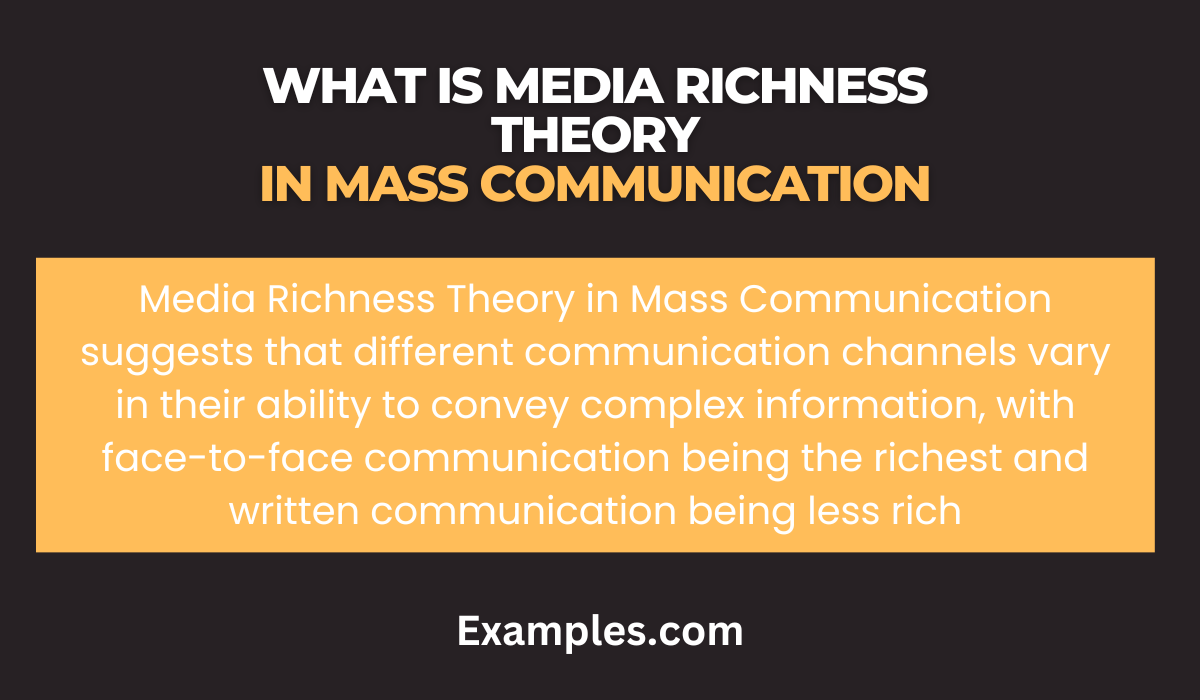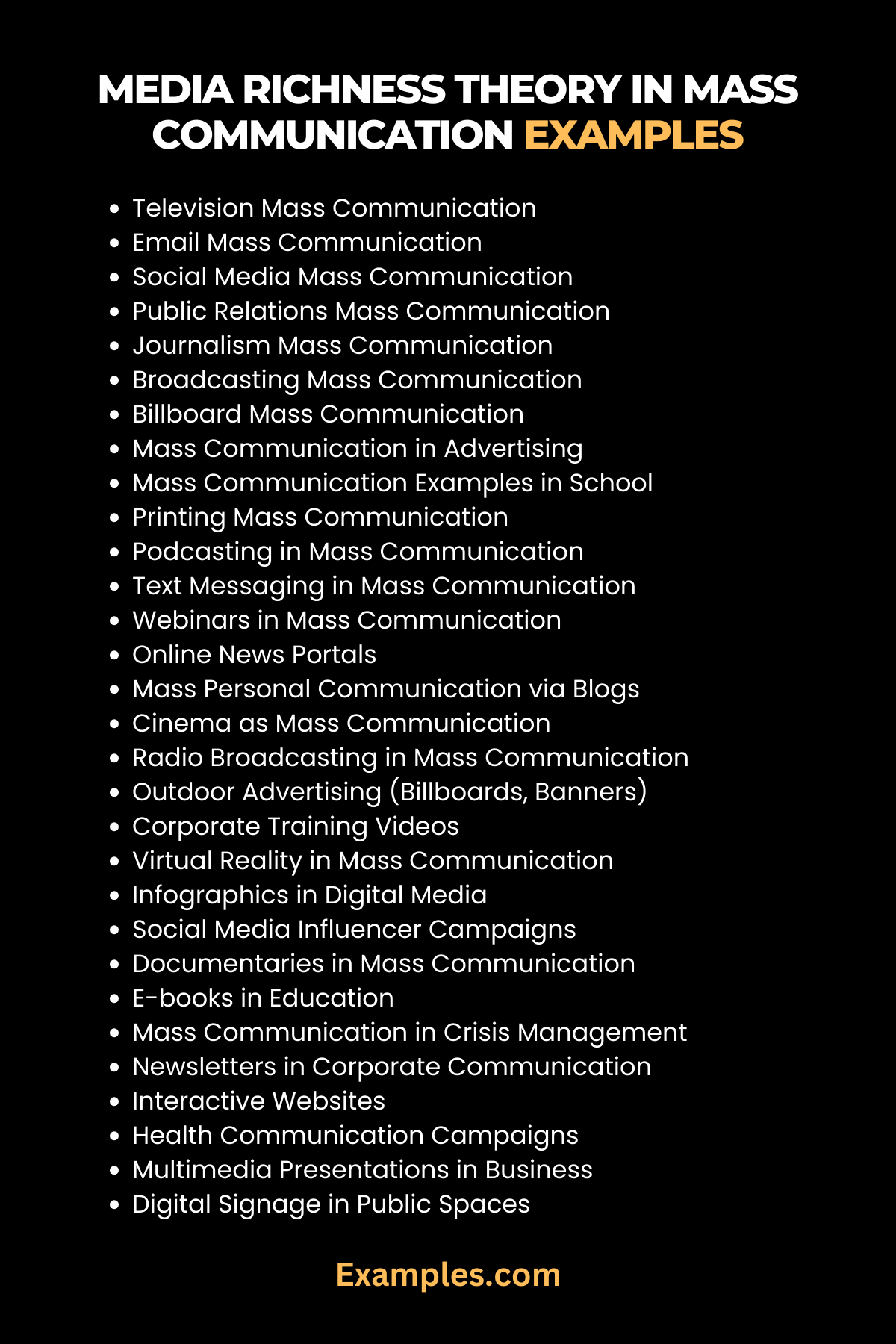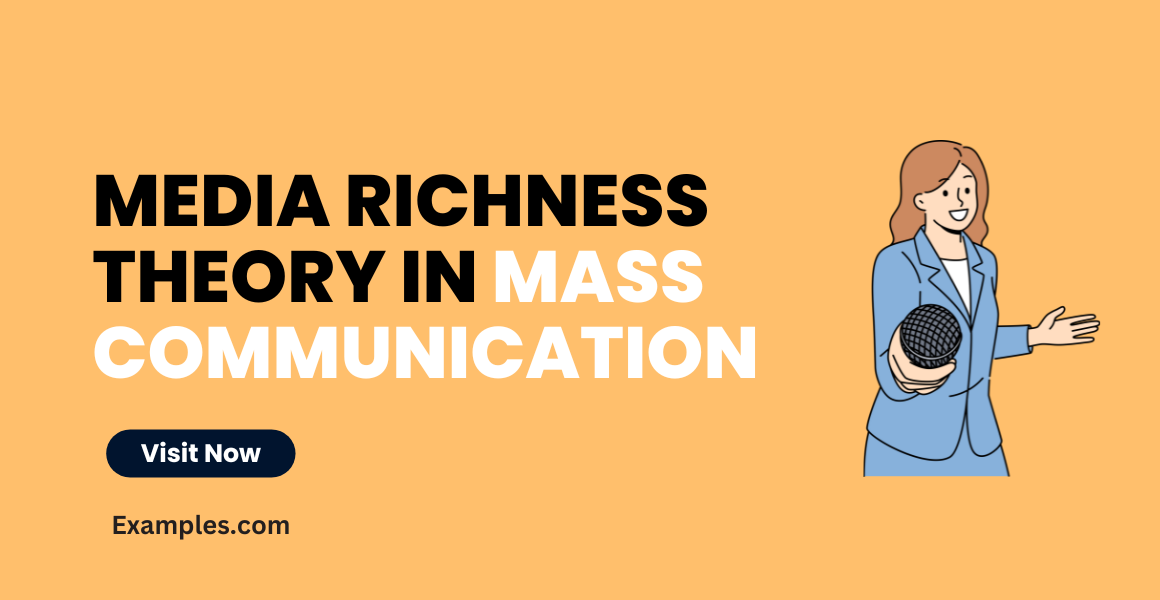Media Richness Theory in Mass Communication
Media Richness Theory in Mass Communication has emerged as a pivotal concept in understanding how different forms of media impact our communication efficacy and understanding. This theory, integral to the landscape of Mass Communication Examples and Mass Communication Characteristics, offers a framework to analyze how media’s richness influences information processing and decision-making in various scenarios. Whether it’s in journalism, digital platforms, or broadcasting, the theory plays a critical role in shaping effective communication strategies. As we delve deeper, we’ll explore its relevance in the dynamic sphere of mass communication, underscoring why this theory is a cornerstone in both academic and practical contexts of media studies.
What is Media Richness Theory in Mass Communication? – Definition
Media Richness Theory (MRT) in mass communication is a significant concept that helps to understand how different communication media can effectively convey complex information. Originating from information processing theory, MRT suggests that media vary in their capacity to enable users to communicate and understand messages. This theory classifies media based on their ability to reproduce the information sent over them, considering aspects like immediate feedback, multiple cues, language variety, and personal focus.
In the context of mass communication, this theory becomes particularly relevant. It helps to evaluate which forms of media are most effective for different types of messages. For instance, a complex and nuanced message might be better communicated through a rich medium like television or video conferencing, which allows for verbal and non-verbal cues, rather than through a leaner medium like a simple text message.

History of Media Richness Theory in Mass Communication
The concept of Media Richness Theory was first introduced in the 1980s by Richard L. Daft and Robert H. Lengel. They developed this theory to explain how the choice of communication media could impact the effectiveness of organizational communication. Initially, MRT was focused on the business and organizational context, but it soon found relevance in the broader field of mass communication.
Over the years, MRT has evolved with the advent of new media technologies. Early assessments of media richness focused on face-to-face communication, telephone conversations, written personal documents, and formal written documents like reports. However, with the emergence of digital media, the scope of MRT has expanded to include social media, emails, blogs, and other forms of digital communication.
What is the Best Example of Media Richness Theory in Mass Communication
A quintessential example of Media Richness Theory in action within the realm of mass communication can be seen in the use of television as a medium. Television, considered a rich medium, offers immediate feedback through live broadcasts, conveys multiple cues through visuals and a, and allows for a varied language use and personal focus. This richness makes television an effective medium for conveying complex and nuanced messages to a large audience.
For instance, in a mass communication scenario, a national leader addressing the nation during a crisis would likely choose a televised address over a written statement. The televised address allows the leader to convey not just the content of the message but also emotional cues through body language and tone, which can be crucial in reassuring or mobilizing the populace.
In summary, Media Richness Theory plays a vital role in understanding the effectiveness of various media in mass communication. Its application helps in choosing the appropriate medium for conveying specific messages, considering the complexity and nuances involved in mass communication contexts.

30 Examples of Media Richness Theory in Mass Communication
Media Richness Theory plays a pivotal role in understanding the impact and efficiency of various communication channels in mass communication. It evaluates how well a communication medium conveys information and promotes understanding. The theory suggests that richer media, capable of transmitting more cues and facilitating rapid feedback, are more effective for complex messages.

- Television Mass Communication: Television, as a rich medium, effectively communicates complex news stories. Its combination of visual and auditory elements enables a deeper understanding of news events, making it a prime example of Media Richness Theory in action.
- Email Mass Communication: Email, considered a less rich medium, is better suited for simpler messages. Its lack of immediate feedback and non-verbal cues aligns with the theory’s perspective on communication effectiveness for straightforward content.
- Social Media Mass Communication: Social media platforms blend text, images, and videos, offering a varied richness. They are effective for both simple and complex messages, demonstrating the theory’s flexibility in different communication contexts.
- Public Relations Mass Communication: In PR, press releases and public statements often utilize rich media like video conferences to effectively manage complex crisis communications, reflecting the theory’s principles.
- Journalism Mass Communication: Investigative journalism often uses rich media like documentary films to convey complex stories with emotional depth, showcasing the theory’s relevance in journalism.
- Broadcasting Mass Communication: Live broadcasting of events provides immediate feedback and a multitude of sensory cues, making it an ideal medium for complex and nuanced messages.
- Billboard Mass Communication: Billboards, featuring simple messages with visual cues, align with the theory by effectively communicating straightforward information in a less rich format.
- Mass Communication in Advertising: Advertising often uses rich media like television and interactive online platforms to convey complex brand stories, demonstrating the theory’s applicability in marketing.
- Mass Communication Examples in School: Educational broadcasts or online learning platforms use media richness to enhance understanding of complex educational content.
- Printing Mass Communication: Printed materials, being less rich, are more suited for direct, uncomplicated messages, as per the theory’s guidelines.
- Podcasting in Mass Communication: Podcasts, primarily a-based, offer a moderate level of richness. They are effective for storytelling and conveying complex ideas through conversation, illustrating the theory’s application in auditory media.
- Text Messaging in Mass Communication: Text messages, with their brevity and lack of non-verbal cues, are less rich according to the theory. They are ideal for simple, direct communication.
- Webinars in Mass Communication: Webinars provide visual and auditory information and allow for real-time interaction, making them a rich medium suitable for detailed instructional content.
- Online News Portals: These platforms combine text, images, and sometimes videos, offering varied richness. They adeptly handle complex news stories, aligning with the theory’s perspective on effective communication.
- Mass Personal Communication via Blogs: Blogs vary in richness, from simple text to multimedia integration. They demonstrate the theory’s principles by catering to different levels of message complexity.
- Cinema as Mass Communication: Films are a rich medium, combining visual, auditory, and sometimes sensory elements, ideal for complex storytelling and deep emotional engagement.
- Radio Broadcasting in Mass Communication: Radio, primarily auditory, is less rich than visual media but effective for storytelling and news reporting, as it conveys tone and emotion effectively.
- Outdoor Advertising (Billboards, Banners): These are less rich media, suitable for simple, impactful messages that can be quickly understood, in line with the theory.
- Corporate Training Videos: These often use rich media, including interactive elements, to effectively communicate complex training material.
- Virtual Reality in Mass Communication: VR is an extremely rich medium, offering immersive experiences. It’s effective for complex simulations and engaging storytelling, exemplifying high media richness.
- Infographics in Digital Media: Combining visual elements with text, infographics are moderately rich and effective for summarizing complex data in an understandable format.
- Social Media Influencer Campaigns: These campaigns often use videos and images, making them rich in non-verbal cues and effective for nuanced marketing messages.
- Documentaries in Mass Communication: Documentaries, with their detailed visual and auditory storytelling, are a rich medium ideal for complex, informative content.
- E-books in Education: E-books offer text and sometimes interactive elements, providing a medium richness suitable for various educational materials.
- Mass Communication in Crisis Management: Crisis communication often utilizes rich media like press conferences and social media to convey complex, sensitive information effectively.
- Newsletters in Corporate Communication: Newsletters, combining text and images, offer moderate richness, suitable for comprehensive corporate updates.
- Interactive Websites: These sites provide a rich user experience with multimedia content, effective for engaging and complex presentations.
- Health Communication Campaigns: These campaigns use various media, from pamphlets (less rich) to interactive apps (rich), to convey health information effectively.
- Multimedia Presentations in Business: Combining text, visuals, and a, these presentations are a rich medium, effective for detailed business communication.
- Digital Signage in Public Spaces: Digital signs, displaying moving images and text, offer moderate richness, suitable for eye-catching, informative displays.
Role of Media Richness Theory in Mass Communication
1. Enhancing Communication Effectiveness: Media Richness Theory plays a crucial role in assessing the effectiveness of different communication media in mass communication. By categorizing media based on their richness, this theory aids in choosing the most suitable medium for a given message, ensuring maximum clarity and understanding.
2. Reducing Ambiguity in Messages: The theory is instrumental in reducing ambiguity in mass communication messages. Richer media, like television and video conferencing, provide more cues (visual, tonal, etc.), making it easier to convey complex or nuanced information effectively.
3. Improving Interpersonal Connection: In mass communication, media richness enhances interpersonal connections between the communicator and the audience. Rich media facilitate more engaging and interactive communication, which is crucial in fields like broadcasting mass communication and public relations mass communication.
4. Adapting to the Audience’s Needs: The theory guides mass communicators in adapting their message to the audience’s needs. Depending on the audience’s familiarity with the subject, different levels of media richness can be employed to communicate effectively.
5. Facilitating Feedback and Interaction: Media Richness Theory underscores the importance of feedback in mass communication. Rich media, like social media platforms, allow for real-time feedback and interaction, making communication more dynamic and responsive.
Importance of Media Richness Theory in Mass Communication
1. Guiding Media Selection: The theory provides a framework for selecting the most appropriate media for different types of messages in mass communication. This is crucial for effective communication in various domains, including journalism mass communication, social media mass communication, and email mass communication.
2. Enhancing Message Clarity and Comprehension: By using the appropriate level of media richness, communicators can enhance the clarity and comprehension of their messages, making them more effective and impactful.
3. Supporting Strategic Communication Planning: Media Richness Theory is essential in strategic communication planning, helping organizations choose the right media mix to reach their target audience effectively.
4. Influencing Public Opinion and Behavior: In mass communication, the right choice of media can significantly influence public opinion and behavior. Rich media, with their ability to convey more nuanced and detailed information, play a vital role in shaping societal views and actions.
5. Adapting to Technological Advancements: The theory remains relevant in the digital age, providing insights into how new and emerging forms of media can be utilized in mass communication. This is particularly important in today’s rapidly evolving media landscape, where digital and social media platforms are becoming increasingly predominant.
How to Use Media Richness Theory in Mass Communication
Applying Media Richness Theory in Mass Communication involves a strategic selection of media based on the nature of the message and the target audience. Here are some tips:
- Analyze the Message Complexity: Determine the complexity of the information you want to convey. Use richer media for more complex messages.
- Consider Audience Preferences and Accessibility: Understand your audience’s media preferences and accessibilities. Younger audiences might prefer digital and interactive media, while older demographics might lean towards traditional media like television or newspapers.
- Utilize Mixed Media Approaches: In some cases, a combination of media can be effective. For example, a campaign might include both Blog Mass Communication for detailed storytelling and social media posts for broader reach and engagement.
- Evaluate and Adapt: Continuously evaluate the effectiveness of the media used. With evolving technology and changing audience behaviors, adaptation is key in mass communication strategies.
Media Richness Theory is essential in Mass Communication for selecting appropriate media based on message complexity and audience preferences, ensuring effective communication and enhanced audience engagement in an ever-evolving digital landscape.



